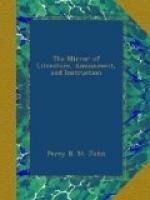“Roll out confectionery paste, the size of the dish intended to receive it; put into a mould representing your pond a lining of almond paste, coloured pale pink, and place in the centre a sort of pedestal of almond paste, supported by lumps of the same paste baked; when dry put it into the stove. Prepare syrup to fill the hollow of the lake, to represent the water; having previously modelled in gum paste little swans, place them in various parts of the syrup; put it into the stove for three hours, then make a small hole through the paste, under your lake, to drain off the syrup; a crust will remain with the swans fixed in it, representing the water. Next build the rock on the pedestal with rock sugar, biscuits, and other appropriate articles in sugar, fixed to one another, supported by the confectionery paste you have put in the middle, the whole being cemented together with caramel, and ornamented. The moulding and heads should then be pushed in almond paste, coloured red; the cascades and other ornaments must be spun in sugar.”
These are, indeed, romantic secrets. Spinning nets and cages with sugar is another fine display of confectionery skill—we say nothing of the nets and cages which our fair friends are sometimes spinning—for the sugar compared with their bonds—are weak as the cords of the Philistines.
* * * * *
THE NATURALIST.
* * * * *
ROOKS.
We glean the following interesting facts from the Essex Herald, as they merit the record of a Naturalist.
“The voracious habits of the rook, and the vast increase of these birds of late years in certain parts of Essex, has been productive of great mischief, especially in the vicinity of Writtle and of Waltham. Since February last, notwithstanding a vigilant watch, the rooks have stolen sets of potatoes from a considerable breadth of ground at Widford Hall. On the same farm, during the sowing of a field of 16 acres with peas, the number of rooks seen at one time on its surface has been estimated at 1,000, which is accounted for by there being a preserve near, which, at a moderate computation, contains 1,000 nests. But the damage done by rooks at Navestock and Kelvedon Hatch, and their vicinities, within a small circle, has been estimated at L2,000. annually. Many farmers pay from 8_s_. to 10_s_. per week, to preserve their seed and plants by watching; but notwithstanding such precautions, acre after acre of beans, when in leaf and clear from the soil, have been pulled up, and the crop lost. The late hurricane proved some interruption to their breeding; and particularly at the estate of Lord Waldegrave, at Navestock, where the young ones were thrown from their nests, and were found under trees in myriads; the very nests blown down, it is said, would have furnished the poor with fuel for a short period.”




